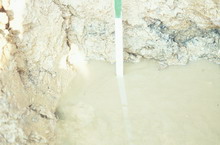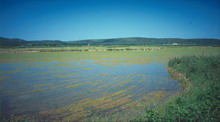|
|
DEGRADATION AND CONTROL PROCESSES |
|
Degradation process:
|
Due to gleization (excess water).
|
Description :
|
Gleization should not be considered a degradation process in all cases, but rather a characteristic of the soils of deltas, estuaries and flood plains, among others.
Importance: this depends on the geographical .
|
Click on the image

Gleization: redox patterns, iron and manganese
oxide mottles and concretions caused by
excess water in the soil
(J. M. Alcaņiz)
|
Soil functions affected:
|
Food production (restricted to species adapted to excess water), hydrological functions (infiltration and percolation affecting the water table), functions relating to supporting buildings and infrastructure.
|
Diagnostic criteria:
|
The presence of hydrophilous plant communities constitutes an indicator. Soil profile study (imperfect drainage, reduction greys or mottling and iron and manganese concretions, presence of sulphides, etc.).
|
Prevention and control:
|
Soils with gleization processes constitute ecosystems to should be protected and that can be used for rice cultivation.
|
Click on the image

Rice cultivation (with denomination of origin)
constitutes a good option for the use of soils
with excess water. Empordā (Girona, Spain)
(J. Porta)
|
|
<< back |
|
|
|